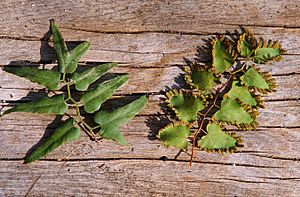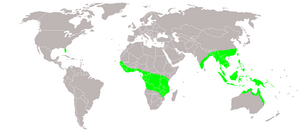Lygodium microphyllum facts for kids
Quick facts for kids Lygodium microphyllum |
|
|---|---|
 |
|
| Underside of spore-bearing leaflets, some leaflets produce spores; others do not. | |
| Conservation status | |
| Scientific classification | |
| Genus: |
Lygodium
|
| Species: |
microphyllum
|
| Synonyms | |
Lygodium microphyllum is a special kind of fern that loves to climb! People call it by many names, like climbing maidenhair fern or Old World climbing fern. It comes from warm, tropical places like Africa, Southeast Asia, and Australia. But in places like Florida, USA, it has become an invasive weed. This means it grows too much and causes problems for other plants and animals. The first official sample of this fern was found in the Philippines by Luis Née.
Contents
Where the Climbing Fern Lives
This climbing fern naturally grows in many parts of tropical Africa and South Africa. You can also find it in tropical Asia, including China and the Ryūkyū Islands of Japan. It also lives in Australia, Fiji, and other Pacific islands like the Mariana Islands and Caroline Islands.
Lygodium microphyllum has also started growing in new places. It has become naturalized in the Caribbean and the southeastern United States. This means it now grows there on its own, even though it's not native to those areas.
How the Climbing Fern Affects Nature
When Lygodium microphyllum grows in new places, it can cause big problems. It is an invasive species, which means it takes over. This fern can harm important wetland areas and even endanger rare animals and plants.
The fern grows very tall, climbing over trees and bushes. It forms thick layers that block sunlight from other plants below. This can reduce the number of different native plants that can grow there. The Old World climbing fern can grow in many different types of environments.
This fern also makes fires worse. It can carry fire up into the tops of trees, which can kill them. This fern has spread quickly in South Florida's protected natural areas.
How We Control the Climbing Fern
Scientists are working to stop the fern from spreading too much. The USDA has allowed the use of certain insects to help control it. These insects, like Austromusotima camptozonale and Neomusotima conspurcatalis, and tiny mites called Floracarus perrepae, have been set free in some state parks.
These tiny helpers eat the fern, which helps to keep it in check. Even though some groups of these insects were hurt by cold weather, new signs of their activity have been seen recently. This means they are still working to control the fern.
Traditional Uses of the Climbing Fern
People in some areas have used Lygodium microphyllum for a long time. In folk medicine, parts of the fern were used to help with skin problems. It was also used to treat swelling and a stomach problem called dysentery.
Other Uses of the Climbing Fern
The strong fibers from Lygodium microphyllum and other types of Lygodium ferns are very useful. These fibers are called nito. In the Philippines, people use nito to weave traditional hats called salakot. These hats are often worn to protect from the sun and rain.



